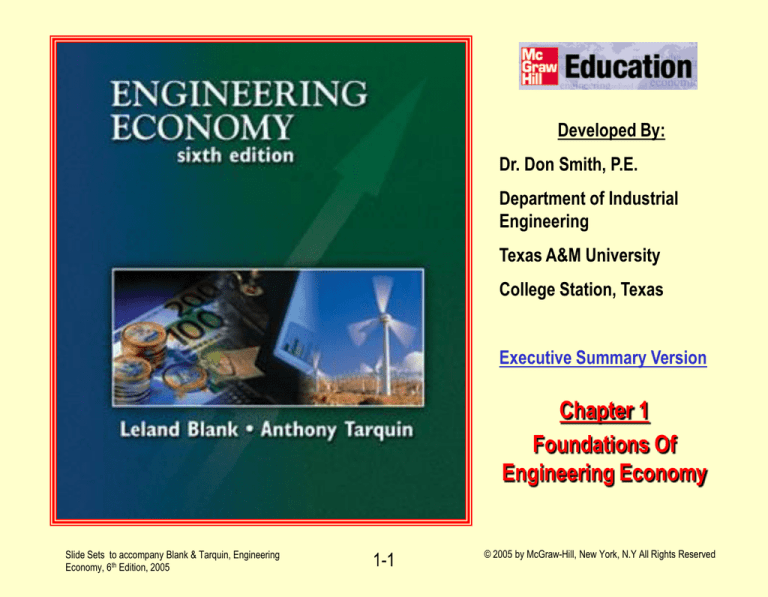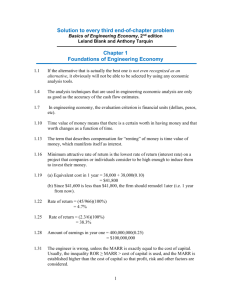
Developed By:
Dr. Don Smith, P.E.
Department of Industrial
Engineering
Texas A&M University
College Station, Texas
Executive Summary Version
Chapter 1
Foundations Of
Engineering Economy
Slide Sets to accompany Blank & Tarquin, Engineering
Economy, 6th Edition, 2005
1-1
© 2005 by McGraw-Hill, New York, N.Y All Rights Reserved
LEARNING OBJECTIVES
1. Questions
7. Symbols
2. Decision making
8. Spreadsheet
functions
3. Study approach
9. Minimum
attractive rate of
return
4. Interest rate
5. Equivalence
6. Simple and
compound
interest
Slide Sets to accompany Blank & Tarquin, Engineering
Economy, 6th Edition, 2005
10.Cash flows
11.Doubling time
12.Spreadsheets
1-2
© 2005 by McGraw-Hill, New York, N.Y All Rights Reserved
Sct 1: Why Engineering Economy is
Important to Engineers
Engineers “design” and create
Designing involves economic decisions
Engineers must be able to incorporate
economic analysis into their creative efforts
Often engineers must select and execute from
multiple alternatives
A proper economic analysis for selection and
execution is a fundamental aspect of
engineering
Slide Sets to accompany Blank & Tarquin, Engineering
Economy, 6th Edition, 2005
1-3
© 2005 by McGraw-Hill, New York, N.Y All Rights Reserved
Engineering Economy
The art and science that involves:
Formulating,
Estimating and
Evaluating economic outcomes
Always concerned with the selection and
possible execution of alternatives given the
economic parameters associated with the
project
Slide Sets to accompany Blank & Tarquin, Engineering
Economy, 6th Edition, 2005
1-4
© 2005 by McGraw-Hill, New York, N.Y All Rights Reserved
Sct 1.2 Role of Engineering Economy in
Decision Making
Decision making involves the estimation of
future events/outcomes
Engineering economy aids in quantifying past
outcomes and forecasting future outcomes
Engineering Economy provides a framework
for modeling problems involving:
Time
Money
Interest rates
Slide Sets to accompany Blank & Tarquin, Engineering
Economy, 6th Edition, 2005
1-5
© 2005 by McGraw-Hill, New York, N.Y All Rights Reserved
The Decision Making Process
1.
2.
3.
4.
5.
Understand the problem – define objectives
Collect relevant information
Define the set of feasible alternatives
Identify the criteria for decision making
Evaluate the alternatives and apply
sensitivity analysis
6. Select the “best” alternative
7. Implement the alternative and monitor
results
Slide Sets to accompany Blank & Tarquin, Engineering
Economy, 6th Edition, 2005
1-6
© 2005 by McGraw-Hill, New York, N.Y All Rights Reserved
Time Value of Money
All firms make use of investment of funds
Investments are expected to earn a return
Investment involves money
Money possesses a “time value”
The “time value” of money is the most
important concept in engineering economy
Slide Sets to accompany Blank & Tarquin, Engineering
Economy, 6th Edition, 2005
1-7
© 2005 by McGraw-Hill, New York, N.Y All Rights Reserved
Sct 1.3 Performing An Engineering
Economy Study
Engineering Economy Studies:
Define Alternatives
Do-nothing alternative – maintain the status quo
Define feasible alternatives – that can solve the problem
Define/estimate the current and future cash flows
Perform the analysis
Apply the tools and methods of engineering economy
Selection of the best alternative
Implement and monitor
Slide Sets to accompany Blank & Tarquin, Engineering
Economy, 6th Edition, 2005
1-8
© 2005 by McGraw-Hill, New York, N.Y All Rights Reserved
Sct 1.4 Interest Rate and Rate of Return
Interest – the manifestation of the time value of money
Rental fee that one pays to use someone else’s
money
Difference between an ending amount of money and a
beginning amount of money
Interest rate (%) =
Slide Sets to accompany Blank & Tarquin, Engineering
Economy, 6th Edition, 2005
interest accrued per time unit
x 100%
original amount
1-9
© 2005 by McGraw-Hill, New York, N.Y All Rights Reserved
Rate of Return
Interest earned over a period of time is expressed as
a percentage of the original amount, specifically;
interest accrued per time unit
Rate of return (%) =
x 100%
original amount
Borrower’s perspective – interest rate paid
Lender’s perspective – interest rate earned
Slide Sets to accompany Blank & Tarquin, Engineering
Economy, 6th Edition, 2005
1-10
© 2005 by McGraw-Hill, New York, N.Y All Rights Reserved
Sct 1.5 Equivalence
Different sums of money at different times
may be equal in economic value
$106 one
year from now
0
Interest rate = 6% per year
1
$100 now
$100 now is said to be equivalent to $106 one year from now, if
the $100 is invested at the interest rate of 6% per year.
Slide Sets to accompany Blank & Tarquin, Engineering
Economy, 6th Edition, 2005
1-11
© 2005 by McGraw-Hill, New York, N.Y All Rights Reserved
Sct 1.6 Simple and Compound Interest
Simple Interest:
Interest = (principal)(number of periods)(interest rate)
Compound Interest:
Interest earns interest on interest
Compounds over time
Interest = (principal + all accrued interest) (interest rate)
Slide Sets to accompany Blank & Tarquin, Engineering
Economy, 6th Edition, 2005
1-12
© 2005 by McGraw-Hill, New York, N.Y All Rights Reserved
Sct 1.7 Terminology and Symbols
P = a present sum of money at a time
designated as t = 0 { t represents time}
F = a future amount of money at some point in
time later than t = 0
A = a series of equal, end-of-period cash
flows
n = the number of interest periods
i = the interest rate or rate of return per time
period, in percent
Slide Sets to accompany Blank & Tarquin, Engineering
Economy, 6th Edition, 2005
1-13
© 2005 by McGraw-Hill, New York, N.Y All Rights Reserved
Sct 1.8 Introduction To Solution By
Computer
Application of Microsoft’s Excel© spreadsheet
program
Excel financial functions
Present Value P:
=PV(i%,n,A,F)
Future Value F:
=FV(i%,n,A,P)
Equal, periodic value:
=PMT(i%,n,P,F)
No. of periods:
=NPER((i%,A,P,F)
Compound interest rate: =RATE(n,A,P,F)
Compound interest rate: =IRR(first_cell:last_cell)
Present value of a series: =NPV(i%,second_cell:last_cell) + first_cell
Slide Sets to accompany Blank & Tarquin, Engineering
Economy, 6th Edition, 2005
1-14
© 2005 by McGraw-Hill, New York, N.Y All Rights Reserved
Sct 1.9 Minimum Attractive Rate of Return
Investors expect to earn a return on their
investment (commitment of funds) over time
We expect to see economic efficiencies greater
than 100%
A profitable investment should earn (return)
funds in excess of the investment amounts
Economic projects should earn a reasonable
return, which is termed:
MARR – Minimum attractive rate of return
Also termed the “hurdle” rate for an investment
Slide Sets to accompany Blank & Tarquin, Engineering
Economy, 6th Edition, 2005
1-15
© 2005 by McGraw-Hill, New York, N.Y All Rights Reserved
The MARR
The MARR is established by the financial
managers of the firm
The MARR is expressed as a percent value
Most, if not all, projects should earn at a rate
equal to or greater than the established MARR
MARR’s are set based upon:
The cost of all types of capital
Allowance for risk
Slide Sets to accompany Blank & Tarquin, Engineering
Economy, 6th Edition, 2005
1-16
© 2005 by McGraw-Hill, New York, N.Y All Rights Reserved
Types of Financing
Equity Financing – the firm uses funds either
from retained earnings, new stock issues, or
owner’s infusion of money
Debt Financing – the firm borrows funds from
outside sources
The cost of debt financing = the interest rate
charged on the debt (loan) amounts
The MARR is approximated from the weighted
average cost of all sources of capital to the
firm
A firm’s ROR > MARR > cost of capital
Slide Sets to accompany Blank & Tarquin, Engineering
Economy, 6th Edition, 2005
1-17
© 2005 by McGraw-Hill, New York, N.Y All Rights Reserved
Sct 1.10 Cash Flows: Their Estimation and
Diagramming
Definition of terms
Cash Inflows - amount of funds flowing into the
firm
Cash Outflows – amount of funds flowing out of the
firm
Net Cash Flow equals
cash inflows – cash outflows
Assumption for analysis – end of period
Funds flow at the end of a given (interest) period
Slide Sets to accompany Blank & Tarquin, Engineering
Economy, 6th Edition, 2005
1-18
© 2005 by McGraw-Hill, New York, N.Y All Rights Reserved
Cash Flow Diagrams
A typical cash flow diagram might look like:
1. Draw a time line
0
1
2
… … …
n-1
n
One time period
2. Show the cash flows
Always assume end-of-period
cash flows!
0
1
2
… … …
n-1
n
Cash flows are shown as directed arrows (+ for up or – for down) --(+) inflow; (-) outflow
Slide Sets to accompany Blank & Tarquin, Engineering
Economy, 6th Edition, 2005
1-19
© 2005 by McGraw-Hill, New York, N.Y All Rights Reserved
Sct 1.11 Rule of 72: Estimating Doubling
Time or Interest Rate
Common question:
Estimate the number of time periods it takes for a
cash flow to double in size
Given an interest rate i% per period
The approximate time n for an investment at time
t = 0 to double in value is given by:
n = 72/i
e.g., $10,000 at 7% per year doubles to $20,000 in
10.3 years
Slide Sets to accompany Blank & Tarquin, Engineering
Economy, 6th Edition, 2005
1-20
© 2005 by McGraw-Hill, New York, N.Y All Rights Reserved
Sct 1.12 Spreadsheet Application
Reference Example 1.18
Design a spreadsheet model to evaluate this
project
Illustrates simple interest, compound interest and
inflation
Focus on the overall design of the model and the
associated formatting
Check appendix A for hints, formats, formulas to
use a spreadsheet effectively
Slide Sets to accompany Blank & Tarquin, Engineering
Economy, 6th Edition, 2005
1-21
© 2005 by McGraw-Hill, New York, N.Y All Rights Reserved
Chapter Summary
Engineering Economy – application of economic
factors and criteria to evaluate alternatives
Applies the time value of money
Application of economic equivalence
Introduction of the MARR
Cash flow estimation
Modeling – cash flow diagrams
Difficulties in estimation
Perspectives – viewpoints taken
Slide Sets to accompany Blank & Tarquin, Engineering
Economy, 6th Edition, 2005
1-22
© 2005 by McGraw-Hill, New York, N.Y All Rights Reserved
End of Slide Set
Slide Sets to accompany Blank & Tarquin, Engineering
Economy, 6th Edition, 2005
1-23
© 2005 by McGraw-Hill, New York, N.Y All Rights Reserved






